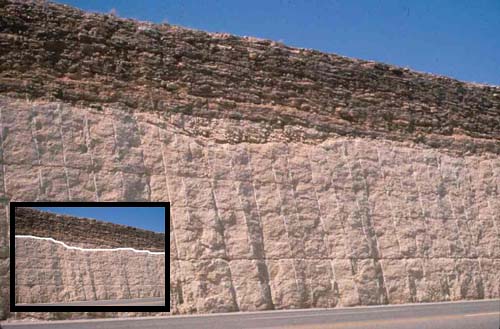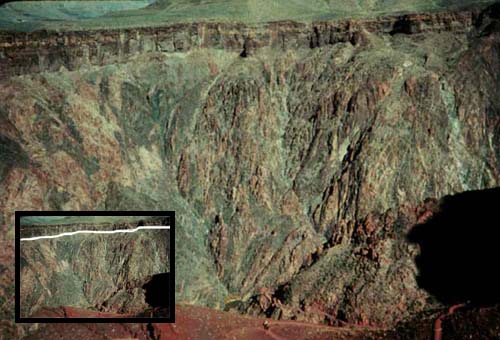
Unconformities
Surfaces called unconformities represent gaps in the geologic record that formed wherever layers were not deposited for a time or, layers that were deposited were subsequently removed by erosion. Essentially an unconformity is a surface of erosion that represents missing rocks. It is as if you tore pages out of a book. There are three kinds of unconformities: A disconformity is an unconformity between parallel strata or lava flows. An angular unconformity is an unconformity between two sets of strata that are not parallel to one another. It forms when new horizontal layers cover up older layers folded by mountain-building processes and are subsequently eroded down to a nearly level surface. A nonconformity is an unconformity between younger sedimentary rocks overlying metamorphic or igneous rocks.

Practice
Identify the following three unconformities.
| UNCONFORMITY 1: The unconformity is located between the dark layers above and the light layers below (highlighted in white on the inset photo). In the center of the photograph (right on the unconformity) you can see an ancient river channel. The vertical lines you see on the outcrop are the remains of where the engineers drilled holes to put in dynamite to blast out the road cut. |
 |
| UNCONFORMITY 2: This photo was taken in the Grand Canyon. The bulk of what you see are the metamorphic rocks known as the Vishnu schist. Above the Vishnu schist are the flat lying, horizontal sedimentary layers known as the Tapeats sandstone. The unconformity is the boundary between these two units (highlighted in white on the inset photo). This unconformity is known as "the great unconformity of the Grand Canyon". |
 |
| UNCONFORMITY 3: This is another photo of the "great unconformity" in the Grand Canyon (highlighted in white on the inset photo). Although this time all of the rocks are sedimentary. Here you can see older tilted sedimentary rocks underlying horizontal layers above. |
 |
|
|
Back to previous page |
Next page |
|